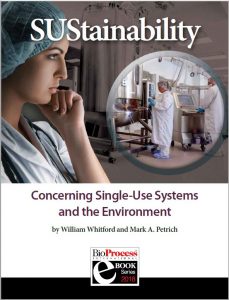 Disposable materials have been used in many aspects of biomanufacturing since muromonab was first launched in 1986. Single-use stirred-tank bioreactors first became commercially available from HyClone in 2004 (1). Despite their demonstrated value to bioprocessing, disposable materials remain the subject of wide-ranging differences of opinion. Discussions of any
Disposable materials have been used in many aspects of biomanufacturing since muromonab was first launched in 1986. Single-use stirred-tank bioreactors first became commercially available from HyClone in 2004 (1). Despite their demonstrated value to bioprocessing, disposable materials remain the subject of wide-ranging differences of opinion. Discussions of any
technology are healthy and important for identifying areas for improvement, but some hearsay and bold propositions made regarding single-use components and the environment are not always helpful. Sustainability is an important and much-publicized topic, and among both lay people and industrial decision-makers is a tendency to automatically equate “disposable” or “plastic” with an environmental liability. Because so many scientists and engineers are involved in biotechnology, we are hopeful that a true technical analysis of sustainability and single-use systems (SUS) for bioprocessing — thus, SUStainability — will get a fair hearing. This is important because the results of such analysis contradict popular opinion. SUS do provide an environmental advantage over traditional durable manufacturing facilities.
No one wants to live with air quality like that of Los Angeles in the 1970s or water quality as in the Hudson River of the same era. So why do biotech professionals resist an opportunity to deploy technology that yields both quality and business benefits while providing for reduced environmental impact? First, although most people sincerely wish to reduce “pollution” and “environmental stress,” confusion comes when they consider how many distinct types of pollution and stress apply. Whether intuitively or through some study, most individuals tend to
focus on some specific particular environmental concern(s) rather than looking at a holistic picture of “sustainability.” Some people are most concerned about landfill use, others are passionate about plastics pollution in the ocean, others are seriously afraid of the consequences of carbon in the atmosphere, and so on. Anthony Noce (vice president of EHS management systems at Tetra Tech) recently remarked, “Unfortunately, green chemistry means different things to different people. I have rarely found it a good thing when different people use the
same term to mean different things” (2). But it’s not as though the issue hasn’t been reviewed at length (3). The true science of the matter is often surprising — even counterintuitive.
Just fill out the form to view and download the complete eBook.
